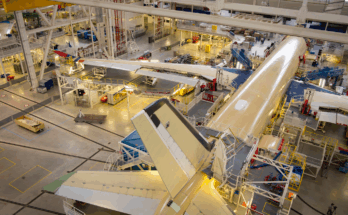By J. Kasper Oestergaard, European Correspondent.
Boeing and Airbus delivered 64 and 44 commercial jets in August 2015, respectively, compared to 58 and 49 in July. In 2015 to date, Boeing has delivered 503 aircraft, ahead of Airbus’ 397. With this, Boeing strengthened its lead in the 2015 delivery race to 106 units, compared to 82 units in July and 73 in June. In 2014 and 2013, Boeing delivered a total of 723 and 648 jets, respectively, compared to Airbus with 629 and 626. Boeing was able to increase its numbers mainly thanks to the ramp up in production of the 787 Dreamliner. However, Airbus will soon be ramping up deliveries of its A350 XWB and gradually begin to close the gap in the deliveries race.
Boeing is expected to deliver 750-755 jets this year, while Airbus’ deliveries will only be slightly higher than last year’s 629 units.
In the orders race, Airbus stormed past Boeing in August 2015 with 341 net new orders, increasing its 2015 total net new orders to date to 708. Boeing “only” booked 67 net new orders in August and has now received 447 net orders this year to date. Airbus’ August bookings were paced by Indian low-cost carrier IndiGo’s order for 250 A320neo jets. This brings IndiGo’s total of A320 series aircraft on order or already delivered to 530, comprising both NEO and CEO variants. In 2014 and 2013, Airbus won the orders race with 1,456 and 1,503 net new orders, ahead of Boeing with 1,432 and 1,355.
In 2015, net new orders will most likely fall from 2014 levels, due, among other factors, to the sharp decline in the price of oil. Cheap oil makes it financially more attractive for airlines to keep operating older, less fuel- efficient aircraft.
With the recent jump in net orders, Airbus’ order backlog now stands at 6,697 jets (of which 5,439, or 81%, are A320 narrowbodies), ahead of Boeing with 5,710 (of which 4,269, or 75%, are A320 narrowbodies). While Boeing has begun to tap its backlog, Airbus’ order book keeps growing.
 Both Boeing and Airbus are facing challenges going forward. Boeing needs to bridge the gap in production between its current-generation 777 (777F and 777-300ER) and the future 777X to maintain the current production rate. Another concern for Boeing is the slump in orders for the 747. Airbus will face challenges as production and deliveries of the A350 XWB ramp up in the coming years. Another Airbus concerns the future of the A380 as the company considers launching a NEO and a stretch variant of the aircraft. In 2015, neither Boeing nor Airbus have booked new orders for their largest aircraft, the 747-8 and A380, respectively.
Both Boeing and Airbus are facing challenges going forward. Boeing needs to bridge the gap in production between its current-generation 777 (777F and 777-300ER) and the future 777X to maintain the current production rate. Another concern for Boeing is the slump in orders for the 747. Airbus will face challenges as production and deliveries of the A350 XWB ramp up in the coming years. Another Airbus concerns the future of the A380 as the company considers launching a NEO and a stretch variant of the aircraft. In 2015, neither Boeing nor Airbus have booked new orders for their largest aircraft, the 747-8 and A380, respectively.
Joakim Kasper Oestergaard is the Managing Director of Forecast International’s AeroWeb subsidiary and a former employee of Barr Group Aerospace. He is an expert in aerospace & defense market intelligence, fuel efficiency in civil aviation, defense spending and defense programs.
A military history enthusiast, Richard began at Forecast International as editor of the World Weapons Weekly newsletter. As the Internet grew in importance as a research tool, he helped design the company's Forecast Intelligence Center and currently coordinates the EMarket Alert newsletters for clients. Richard also manages social media efforts, including two new blogs: Defense & Security Monitor, covering defense systems and international issues, and Flight Plan, which focuses on commercial aviation and space systems. For over 30 years, Richard has authored the Defense & Aerospace Companies, Volume I (North America) and Volume II (International) services. The two books provide detailed data on major aerospace and defense contractors. He also edits the International Contractors service, a database that tracks all the contractors involved in the programs covered in the FI library. More recently he was appointed Manager, Information Services Group (ISG), a new unit that encompasses developing outbound content for both Forecast International and Military Periscope.




